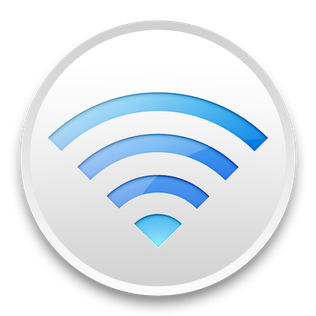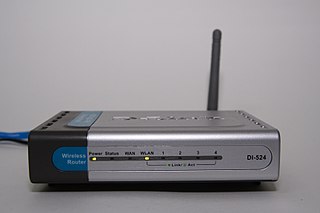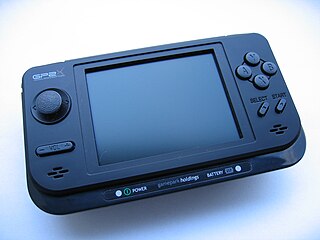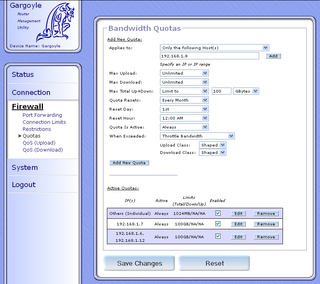Related Research Articles

AirPort is the name given to a series of products by Apple Inc. using the Wi-Fi protocols. These products comprise a number of wireless routers and wireless cards. The AirPort Extreme name was originally intended to signify the addition of the 802.11g protocol to these products.

Network-attached storage (NAS) is a file-level computer data storage server connected to a computer network providing data access to a heterogeneous group of clients. NAS is specialized for serving files either by its hardware, software, or configuration. It is often manufactured as a computer appliance – a purpose-built specialized computer. NAS systems are networked appliances that contain one or more storage drives, often arranged into logical, redundant storage containers or RAID. Network-attached storage removes the responsibility of file serving from other servers on the network. They typically provide access to files using network file sharing protocols such as NFS, SMB, or AFP. From the mid-1990s, NAS devices began gaining popularity as a convenient method of sharing files among multiple computers. Potential benefits of dedicated network-attached storage, compared to general-purpose servers also serving files, include faster data access, easier administration, and simple configuration.

Linksys is an American company selling data networking hardware products mainly to home users and small businesses. Its products include wired and wireless routers, Ethernet switches, VoIP equipment, wireless Internet video cameras, audio visual products and network storage systems.
LenovoEMC, sometimes styled lenovo | EMC², is a producer of external, portable, and networked storage products. Established in the 1980s in Roy, Utah, as Iomega, LenovoEMC has sold more than 410 million digital storage drives and disks. It was formerly a public company. The Zip drive was Iomega's most notable product.

The Linksys WRT54G Wi-Fi series is a series of Wi-Fi–capable residential gateways marketed by Linksys, a subsidiary of Cisco from 2003 until acquired by Belkin in 2013. A residential gateway connects a local area network to a wide area network.

A wireless router is a device that performs the functions of a router and also includes the functions of a wireless access point. It is used to provide access to the Internet or a private computer network. Depending on the manufacturer and model, it can function in a wired local area network, in a wireless-only LAN, or in a mixed wired and wireless network.

The GP2X is a Linux-based handheld video game console and portable media player developed by South Korean company GamePark Holdings. It was released on November 10, 2005, in South Korea only.

DD-WRT is Linux-based firmware for wireless routers and access points. Originally designed for the Linksys WRT54G series, it now runs on a wide variety of models. DD-WRT is one of a handful of third-party firmware projects designed to replace manufacturer's original firmware with custom firmware offering additional features or functionality.
The NSLU2 is a network-attached storage (NAS) device made by Linksys introduced in 2004 and discontinued in 2008. It makes USB flash memory and hard disks accessible over a network using the SMB protocol. It was superseded mainly by the NAS200 and in another sense by the WRT600N and WRT300N/350N which both combine a Wi-Fi router with a storage link.

My Book is a series of external hard drives produced by Western Digital. There are currently nine series of My Book drives; Essential Edition, Home Edition, Office Edition, Mirror Edition, Studio Edition, Premium Edition, Elite Edition, Pro Edition, AV Dvr "Live Edition", and the World Edition.

The Buffalo TeraStation network-attached storage series are network-attached storage devices.

Intel Active Management Technology (AMT) is hardware and firmware for remote out-of-band management of select business computers, running on the Intel Management Engine, a separate microprocessor not exposed to the user, in order to monitor, maintain, update, upgrade, and repair them. Out-of-band (OOB) or hardware-based management is different from software-based management and software management agents.

The Huawei E220 is a Huawei HSDPA access device (modem) manufactured by Huawei and notable for using the USB interface.
Optware is a free software package manager for embedded systems. Originally developed as a distribution mechanism for the Unslung Linux distribution for the Linksys NSLU2, Optware has been adopted by a variety of hobbyist communities and device developers.

The Seagate Barracuda is a series of hard disk drives produced by Seagate Technology. Most of the drives in this series have a spindle speed of 7200 RPM. The line initially focused on high-capacity, high-performance SCSI drives; since 2001, it became Seagate's most popular product as the hard disk drive industry started to move to a 7200 RPM spindle speed.
Free Software Foundation, Inc. v. Cisco Systems, Inc. was a lawsuit initiated by the Free Software Foundation (FSF) against Cisco Systems on December 11, 2008 in the United States District Court for the Southern District of New York. The FSF claimed that various products sold by Cisco under the Linksys brand had violated the licensing terms of many programs on which FSF held copyright, including GCC, GNU Binutils, and the GNU C Library. Most of these programs were licensed under the GNU General Public License, and a few under the GNU Lesser General Public License. The Software Freedom Law Center acted as the FSF's law firm in the case. The foundation asked the court to enjoin Cisco from further distributing Linksys firmware that contains FSF copyrighted code, and also asked for all profits that Cisco received "from its unlawful acts." Cisco stated that they were reviewing the issues in the suit, but they believe to be "substantially in compliance".
Linksys manufactures a series of network routers. Many models are shipped with Linux-based firmware and can run third-party firmware. The first model to support third-party firmware was the very popular Linksys WRT54G series.

Gargoyle is a free OpenWrt-based Linux distribution for a range of wireless routers based on Broadcom or Atheros chipsets, Asus Routers, Netgear, Linksys and TP-Link routers. Among notable features is the ability to limit and monitor bandwidth and set bandwidth caps per specific IP address.

XigmaNAS is a network-attached storage (NAS) server software with a dedicated management web interface. It is free software under the terms of the Simplified BSD license.

A personal cloud is a collection of digital content and services which are accessible from any device. The personal cloud is not a tangible entity. It is a place which gives users the ability to store, synchronize, stream and share content on a relative core, moving from one platform, screen and location to another. Created on connected services and applications, it reflects and sets consumers’ expectations for how next-generation computing services will work.
References
- ↑ "Network Attached Storage System with 2 Bays: NAS200". Cisco Systems. Retrieved June 9, 2011.
- ↑ Henry Kingman (September 6, 2007). "Linux-based SLUG spawns highly hackable NAS". LinuxDevices.com . Archived from the original on September 9, 2012.
- ↑ Matthew Sparkes (November 12, 2007). "Linksys NAS200". PC Pro . Archived from the original on June 19, 2009. Retrieved June 9, 2011.
- ↑ Oliver Rist (October 25, 2007). "Linksys NAS200". PC Magazine . Retrieved June 9, 2011.